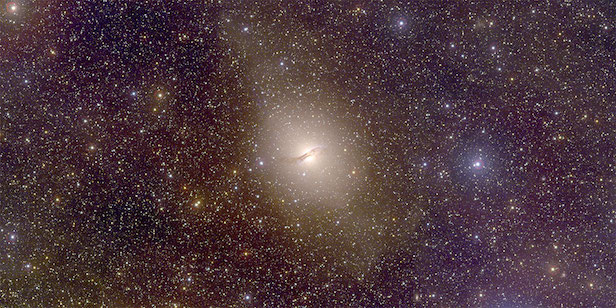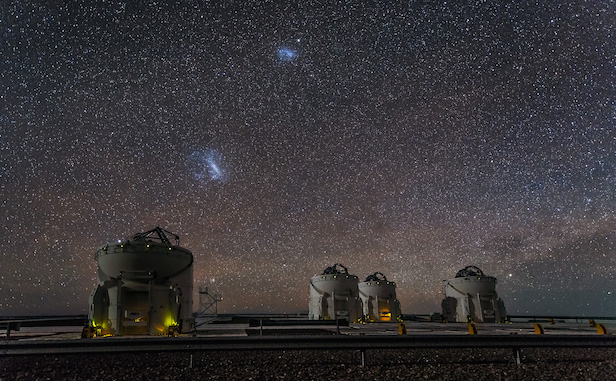Small galaxies challenge dark matter
New studies of satellite galaxies in Centaurus A show results that challenge our current understanding of almost 27 per cent of the universe

Centaurus A lies 13 million light years away from us, and its satellite galaxies challenge our current understanding of dark matter. Image credit: ANU/SkyMapper
According to our currently accepted cosmology theory, dark matter makes up almost 27 per cent of our entire universe. Although we have not directly seen it, our previous observations of galaxies, and how dark matter affects them, supports this idea. However, new studies of the movements and distribution of dwarf galaxies in the constellation of Centaurus seem to contradict our current understanding of the universe.
“The significance of this finding is that it calls into question the validity of certain cosmological models and simulations as explanations for the distribution of host and satellite galaxies in the universe,” says Marcel Pawlowski, a Hubble Fellow in the Department of Physics & Astronomy at the University of California, Irvine.
Our Milky Way is surrounded by a group of its own dwarf galaxies, including the Large and Small Magellanic Cloud among others. If the dark matter theory was correct, then these dwarf galaxies would be distributed randomly and orbit in an erratic fashion. Galaxies should also mainly consist of invisible dark matter, which again has yet to be directly observed.
Observations of the satellite galaxies around the Milky Way and Andromeda galaxy from years ago challenge this model. It was discovered that the satellite galaxies, in orbit around their superior, are arranged in a disc shaped plane and co-rotate within these planes.
Supporters of this model have claimed that these are just outliers, and that the standard model of cosmology still holds true. The recent findings by an international team of astronomers have found another so-called ‘outlier’, thus disputing that these are in fact widespread phenomena across the universe.

The Small and Large Magellanic Clouds are two prominent satellite galaxies orbiting the Milky Way. Image credit: ESO/ J. Colosimo
Astronomers analysing the locations and movement of satellite galaxies around the galaxy Centaurus A, which lies 13 million light years away. The locations of the satellite galaxies are located on a perpendicular plane compared to the grander galactic disk. By measuring the Doppler effect – the change in a galaxy’s spectrum with regards to a non-moving galaxy – to determine the movement of such objects.
The results showed that 14 out of 16 satellite galaxies follow the same orbit around the perpendicular plane. If the current dark matter theory was true, only half a percent of the satellite galaxies in the surrounding universe should behave in this way.
“Coherent movement seems to be a universal phenomenon that demands new explanations,” says Oliver Müller from the University of Basel’s Department of Physics. These observations challenge the simulations of our universe, assuming dark matter is present. Now that three galaxies have been observed – the Milky Way, Andromeda and now Centaurus A – for this to be a coincidence is highly unlikely.
The standard model of cosmology cannot explain why how these similar orbits arise around a superior galaxy, but they do strength the theory that dwarf galaxies form during the collision of two larger galaxies. These satellite galaxies could be the result of debris launched out from tidal forces during the merger.
Keep up to date with the latest reviews in All About Space – available every month for just £4.99. Alternatively you can subscribe here for a fraction of the price!




